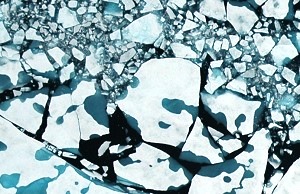Reading scientists accurately predict Arctic sea ice melt
Release Date 24 September 2014

Arctic sea ice reached its minimum extent for 2014 last week, the sixth lowest level since records began - as predicted by University of Reading scientists three months ago.
The ice covered just over 5 million square km on Wednesday (17 September). All the record lows have occurred since 2007.
While long-term predictions all agree that the levels of ice in the summer are going down, predicting how low the ice will go each year has, up to now, been very difficult. However, this year's figure confirms the accuracy of the most skilful method yet, developed by University of Reading scientists.
It is hoped that the new system could not only have practical applications, such as helping shipping companies plan passages through emerging Arctic sea lanes, but will also improve the accuracy of computer simulations of how the global climate will change in the future.
Professor Daniel Feltham, who leads the NERC Centre for Polar Observation and Modelling team at the University of Reading, yesterday (Tuesday) told a conference on sea ice at the Royal Society that his group simulated low levels of melt ponds across the Arctic ice in May.
Using the new method, which analyses the size and coverage of ‘melt ponds' on the surface of the sea ice, the team predicted in June that the September 2014 sea ice minimum would be 5.4 million km2 (4.9-5.9 million km2), close to the level in 2013. The actual figure was just over 5 million km2.
Professor Feltham said: "Melt ponds are crucial to the speed of the annual ice melt, as the dark water on the surface absorbs more energy from the sun than the white ice, which reflects much of it back into space."
While the 2014 value for sea ice extent is higher than the all-time low in 2012 of 3.4 million km2, this does not mean that the sea ice decline has stopped. It would still be 18% below the 1981-2010 average of 6.5 million km2.
Dr Ed Hawkins, from the National Centre for Atmospheric Science (NCAS) at the University of Reading, said: "Polar sea ice at the poles melts off in the summer, and re-freezes in winter. But as a result of human-induced climate change, temperatures at the poles are increasing rapidly.
"In the Arctic, this is causing a long-term decline in ice extent. While estimates vary, it's likely that summer sea ice will disappear altogether by the middle of this century."
This week there are two international meetings about Arctic sea ice, at the Royal Society, London 22-23 September, and at the Royal Society, Chicheley Hall 24-25 September.
The melt pond model was developed by Daniela Flocco and Daniel Feltham and applied to Arctic prediction by David Schröder, Daniel Feltham, Daniela Flocco, and Michel Tsamados from the NERC Centre for Polar Observation and Modelling at the University of Reading and was featured on the front cover of the May 2014 issue of Nature Climate Change.